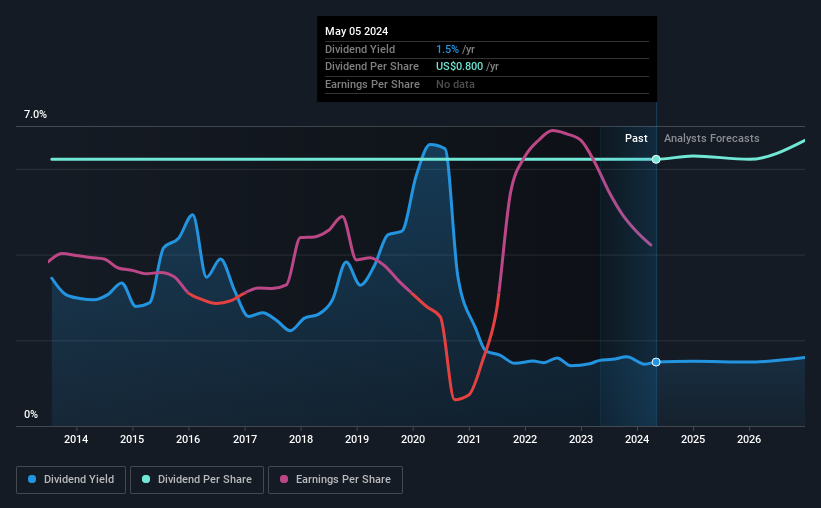Should You Buy Olin Corporation (NYSE:OLN) For Its Upcoming Dividend?
It looks like Olin Corporation (NYSE:OLN) is about to go ex-dividend in the next two days. Typically, the ex-dividend date is one business day before the record date which is the date on which a company determines the shareholders eligible to receive a dividend. The ex-dividend date is important because any transaction on a stock needs to have been settled before the record date in order to be eligible for a dividend. Accordingly, Olin investors that purchase the stock on or after the 8th of May will not receive the dividend, which will be paid on the 14th of June.
The company's next dividend payment will be US$0.20 per share, and in the last 12 months, the company paid a total of US$0.80 per share. Based on the last year's worth of payments, Olin stock has a trailing yield of around 1.5% on the current share price of US$53.63. If you buy this business for its dividend, you should have an idea of whether Olin's dividend is reliable and sustainable. As a result, readers should always check whether Olin has been able to grow its dividends, or if the dividend might be cut.
View our latest analysis for Olin
Dividends are typically paid from company earnings. If a company pays more in dividends than it earned in profit, then the dividend could be unsustainable. That's why it's good to see Olin paying out a modest 28% of its earnings. A useful secondary check can be to evaluate whether Olin generated enough free cash flow to afford its dividend. Luckily it paid out just 14% of its free cash flow last year.
It's encouraging to see that the dividend is covered by both profit and cash flow. This generally suggests the dividend is sustainable, as long as earnings don't drop precipitously.
Click here to see the company's payout ratio, plus analyst estimates of its future dividends.
Have Earnings And Dividends Been Growing?
Companies with consistently growing earnings per share generally make the best dividend stocks, as they usually find it easier to grow dividends per share. If earnings fall far enough, the company could be forced to cut its dividend. With that in mind, we're encouraged by the steady growth at Olin, with earnings per share up 8.5% on average over the last five years. Management have been reinvested more than half of the company's earnings within the business, and the company has been able to grow earnings with this retained capital. We think this is generally an attractive combination, as dividends can grow through a combination of earnings growth and or a higher payout ratio over time.
Another key way to measure a company's dividend prospects is by measuring its historical rate of dividend growth. Olin's dividend payments are effectively flat on where they were 10 years ago.
To Sum It Up
Is Olin worth buying for its dividend? Earnings per share growth has been growing somewhat, and Olin is paying out less than half its earnings and cash flow as dividends. This is interesting for a few reasons, as it suggests management may be reinvesting heavily in the business, but it also provides room to increase the dividend in time. We would prefer to see earnings growing faster, but the best dividend stocks over the long term typically combine significant earnings per share growth with a low payout ratio, and Olin is halfway there. Overall we think this is an attractive combination and worthy of further research.
In light of that, while Olin has an appealing dividend, it's worth knowing the risks involved with this stock. In terms of investment risks, we've identified 3 warning signs with Olin and understanding them should be part of your investment process.
Generally, we wouldn't recommend just buying the first dividend stock you see. Here's a curated list of interesting stocks that are strong dividend payers.
Have feedback on this article? Concerned about the content? Get in touch with us directly. Alternatively, email editorial-team (at) simplywallst.com.
This article by Simply Wall St is general in nature. We provide commentary based on historical data and analyst forecasts only using an unbiased methodology and our articles are not intended to be financial advice. It does not constitute a recommendation to buy or sell any stock, and does not take account of your objectives, or your financial situation. We aim to bring you long-term focused analysis driven by fundamental data. Note that our analysis may not factor in the latest price-sensitive company announcements or qualitative material. Simply Wall St has no position in any stocks mentioned.

 Yahoo Finance
Yahoo Finance 
